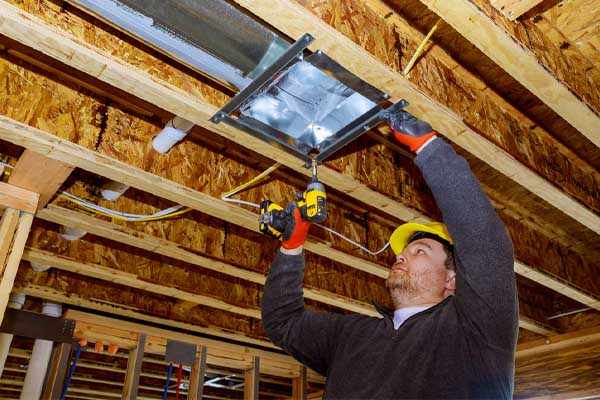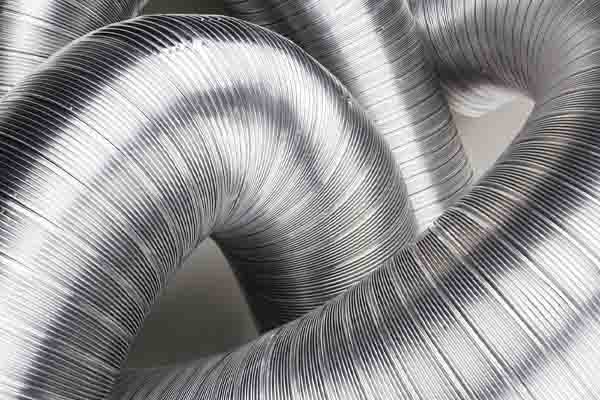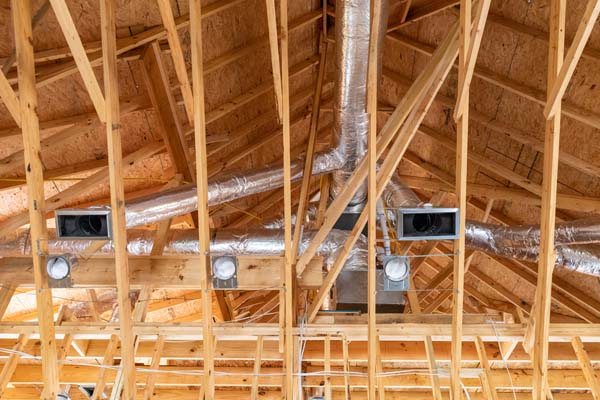The Importance Of Ductwork Design

HVAC ductwork plays a pivotal role in maintaining indoor comfort. This article delves into the importance of ductwork, intricately connecting heating and cooling components to deliver conditioned air throughout different spaces in the house or building. Ductwork design is key to ensuring optimal HVAC performance. From distributing airflow to maintaining consistent temperatures, understanding the impact of well-designed ductwork is the foundation of a comfortable and energy-efficient environment. Read on to learn more.
Understanding Ductwork Design
Contents
- 1 Understanding Ductwork Design
- 1.1 HVAC Ductwork: Energy Efficiency & Cost Savings
- 1.2 Proper HVAC Airflow & Comfort
- 1.3 Noise Reduction & HVAC Performance
- 1.4 Addressing Common Heating & Cooling Ductwork Issues
- 1.5 Effective Strategies to Improve Heating & AC Ductwork
- 1.6 Considerations for New Installations and Upgrades
- 1.7 Conclusion
- 2 Call McAllister Energy For All Of Your HVAC Requirements

Ductwork design involves planning and creating a system of pathways that allow heated or cooled air to travel throughout the building. It includes determining the layout, size, and materials of the ducts.
Proper sizing and layout of ductwork are essential for efficient air distribution. Incorrect sizing can lead to insufficient airflow or energy waste. An optimized layout guarantees even temperature distribution and reduces pressure drops. This enhances overall system performance.
Ductwork materials impact its performance. There are several ductwork materials, but these are the most commonly used:
- Flexible Ducts: These are versatile and easy to install but may lead to air leakage.
- Sheet Metal Ducts: These are durable and resistant to leakage. However, they require careful design and sealing.
Choosing the right material is crucial for balancing efficiency, durability, and cost-effectiveness in HVAC systems.
Related Article: Must-Have Accessories to Improve HVAC Performance
HVAC Ductwork: Energy Efficiency & Cost Savings
Ductwork design is important to achieve energy efficiency. Properly designed ducts help maintain balanced airflow, minimizing energy loss due to leaks or inadequate insulation.
Well-designed ducts lead to reduced utility bills by making sure that conditioned air reaches its intended destinations efficiently. Improved energy consumption also contributes to lowering overall operating costs.
Properly sealed and insulated ductwork results in the following:
- Prevention of air leakage
- Reduces heat transfer
- Enhance energy efficiency
- Consistent indoor temperatures
- Improved overall HVAC performance
- Increased comfort
- Increased savings
Related Article: How Long Does Ductwork Last?
Proper HVAC Airflow & Comfort
Ductwork design is paramount in achieving balanced airflow. It ensures that conditioned air reaches all the areas of a building evenly. This design approach maintains consistent temperatures and prevents overworking the HVAC system.
Well-designed ducts help eliminate hot and cold spots within spaces. Even distribution of heated or cooled air creates a comfortable environment throughout the building, enhancing occupant comfort and satisfaction.
Effective ductwork design improves indoor air quality by efficiently filtering and distributing air. Properly designed ducts prevent dust and contaminants from accumulating, enhancing overall comfort and well-being. Prioritizing well-designed ducts enhances both physical comfort and indoor air quality.
Related Article: Tips on How to Protect Your HVAC Warranty
Noise Reduction & HVAC Performance
Ductwork design influences HVAC system noise levels, contributing to the overall comfort and tranquility of indoor spaces.
- Airflow Restrictions and Noise: Poorly designed ducts with sharp turns, excessive bends, or inadequate sizing can restrict airflow. Air moving through constricted pathways generates turbulent airflow and increased noise levels. Properly designed ducts with gradual bends and smooth transitions minimize airflow disruptions and reduce noise.
- Noise Transmission: Inadequately insulated or sealed ducts can transmit noise from the HVAC equipment to occupied spaces. Vibrations and mechanical sounds from the system can resonate through the vents, creating unwanted noise in different building areas. Proper insulation and sealing dampen vibrations and prevent noise transmission.
- Duct Material and Thickness: The choice of duct material can influence noise levels. Some materials, like sheet metal, have no sound-absorbing properties that help minimize noise. Thicker duct walls can provide better noise insulation compared to thinner materials.
- Duct Placement and Distance: Careful duct placement can prevent noise from entering sensitive areas. Ducts running through quiet zones, such as bedrooms or offices, should be strategically routed to minimize noise disturbances. Increased distance between the HVAC equipment and occupied spaces can also help mitigate noise issues.
- Acoustic Considerations: Ductwork design can incorporate acoustic features to reduce noise. These include adding sound-absorbing materials within the ducts or using silencers and baffles to mitigate noise propagation.
Minimizing noise in an HVAC system is not only about creating a quieter environment but also enhancing overall efficiency. Excessive noise can lead to discomfort, stress, and even health issues for occupants. A quiet system is indicative of proper functioning and optimal performance.
Ductwork design has a direct impact on the performance of HVAC equipment. Poorly designed ducts can lead to airflow restrictions, causing the system to work harder to maintain desired temperatures. This results in increased energy consumption, reduced efficiency, and unnecessary wear and tear on components.
Addressing Common Heating & Cooling Ductwork Issues
Common ductwork problems, such as leaks, improper insulation, and inadequate sizing, can severely impact HVAC systems. Leaks lead to energy waste, decreased efficiency, and inconsistent temperatures. Poor insulation causes heat loss or gain, compromising indoor comfort. Improperly sized ducts result in inadequate airflow and strain on the system.
Related Article: Why Is Condensation On Air Ducts A Cause For Concern?
Effective Strategies to Improve Heating & AC Ductwork
- Seal ducts
- Add insulation
- Resize ducts to match the system
- Incorporate gradual bends, smooth transitions, and even distribution
Professional ductwork inspections and repairs are essential. HVAC specialists can identify hidden problems. Assess overall system performance and recommend appropriate solutions. Regular maintenance and timely repairs ensure that ductwork remains efficient and trouble-free, contributing to the HVAC system’s longevity and optimal performance.
Related Article: When to Call Emergency HVAC Services
Considerations for New Installations and Upgrades

For new constructions, factors like building layout, room sizes, and HVAC load, play a crucial role in ductwork design. Proper sizing, layout, and material selection are essential to guarantee even airflow distribution and efficient heating or cooling.
Upgrading existing duct systems involves evaluating current performance and identifying areas for improvement. Upgrades may include resizing ducts, adding insulation, or sealing leaks to enhance efficiency and comfort.
Collaborating with HVAC professionals is pivotal in achieving optimal ductwork design. They assess specific needs, calculate load requirements, and recommend design adjustments or upgrades tailored to the building’s unique characteristics. Professional expertise ensures that new installations or upgrades align with energy efficiency standards and deliver effective HVAC performance.
Related Article: How HVAC Comfort Zones Cut Energy Costs
Conclusion
We have explored how well-designed ducts influence everything from energy efficiency and comfort to noise levels and system longevity. Layout, proper sizing, and material choice are integral to creating a harmonious indoor environment. By prioritizing professional ductwork design, homeowners are assured that their HVAC systems function at their best, fostering comfort, efficiency, and the well-being of both occupants and the environment.
Related Article: Is Your HVAC System Protected From Power Surges?
Call McAllister Energy For All Of Your HVAC Requirements

McAllister Energy is the leading provider of heating and cooling services in southern New Jersey. Our team comprises highly skilled and certified technicians specializing in HVAC tune-ups, repairs, installations, and replacements. We take pride in delivering top-quality services to all our clients.
At McAllister Energy, we understand the importance of having a comfortable and energy-efficient home. That is why we offer competitive pricing for our services. Our maintenance services are designed to enhance comfort and reduce energy bills. If you require an HVAC repair or replacement, our knowledgeable technicians can recommend the best option while keeping your budget in mind. We stand behind our work and offer a satisfaction guarantee.
To schedule a service appointment with us, simply give us a call. We offer free, in-home estimates to help you make informed decisions about your HVAC systems. You can trust McAllister Energy to provide exceptional heating and cooling services that will exceed your expectations!
You can click here to contact us now or call us at (856) 665-4545 to find out more! Click the link to view our service area.